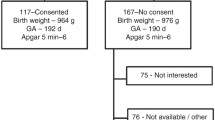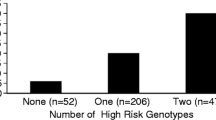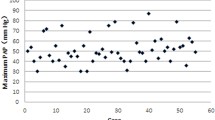Abstract
Objective
The D allele of the I/D polymorphism in the angiotensin-converting enzyme (ACE) gene has been associated with an increased risk of ARDS in critically ill adults and severity of bronchopulmonary dysplasia in pre-term infants. We hypothesised that the presence of the hypoxia-associated ACE D allele would increase susceptibility to acute hypoxic respiratory failure (AHRF) in a cohort of critically ill children.
Design and setting
Single-centre prospective observational cohort study.
Patients
Children under 16 years of age requiring admission to a tertiary general PICU.
Measurements and results
A total of 216 Caucasian patients were enrolled. Thirty (13.9%) children developed AHRF and 13 were diagnosed with ARDS (6.0%). There was no significant difference in ACE D allele frequency between patient groups with or without AHRF (0.53 vs. 0.54).
Conclusions
Variation in ACE activity does not influence the development of paediatric AHRF. This may reflect a different pathogenesis from adult ARDS.

Similar content being viewed by others
References
Erdos EG, Skidgel RA (1987) The angiotensin I-converting enzyme. Lab Invest 56:345–348
Kiely DG, Cargill RI, Lipworth BJ (1995) Acute hypoxic pulmonary vasoconstriction in man is attenuated by type I angiotensin II receptor blockade. Cardiovasc Res 30:875–880
Reddy HK, Campbell SE, Janicki JS, Zhou G, Weber KT (1993) Coronary microvascular fluid flux and permeability: influence of angiotensin II, aldosterone, and acute arterial hypertension. J Lab Clin Med 121:510–521
Rigat B, Hubert C, Alhenc-Gelas F, Cambien F, Corvol P, Soubrier F (1990) An insertion/deletion polymorphism in the angiotensin I-converting enzyme gene accounting for half the variance of serum enzyme levels. J Clin Invest 86:1343–1346
Costerousse O, Allegrini J, Lopez M, Alhenc-Gelas F (1993) Angiotensin I-converting enzyme in human circulating mononuclear cells: genetic polymorphism of expression in T-lymphocytes. Biochem J 290(Pt 1):33–40
Bloem LJ, Manatunga AK, Pratt JH (1996) Racial difference in the relationship of an angiotensin I-converting enzyme gene polymorphism to serum angiotensin I-converting enzyme activity. Hypertension 27:62–66
Marshall RP, Webb S, Bellingan GJ, Montgomery HE, Chaudhari B, McAnulty RJ, Humphries SE, Hill MR, Laurent GJ (2002) Angiotensin converting enzyme insertion/deletion polymorphism is associated with susceptibility and outcome in acute respiratory distress syndrome. Am J Respir Crit Care Med 166:646–650
Villar J, Flores C, Perez-Mendez L, Maca-Meyer N, Espinosa E, Blanco J, Sanguesa R, Muriel A, Tejera P, Muros M, Slutsky AS (2008) Angiotensin-converting enzyme insertion/deletion polymorphism is not associated with susceptibility and outcome in sepsis and acute respiratory distress syndrome. Intensive Care Med 34:488–495
Kazzi SN, Quasney MW (2005) Deletion allele of angiotensin-converting enzyme is associated with increased risk and severity of bronchopulmonary dysplasia. J Pediatr 147:818–822
Harding D, Baines PB, Brull D, Vassiliou V, Ellis I, Hart A, Thomson AP, Humphries SE, Montgomery HE (2002) Severity of meningococcal disease in children and the angiotensin-converting enzyme insertion/deletion polymorphism. Am J Respir Crit Care Med 165:1103–1106
Gayagay G, Yu B, Hambly B, Boston T, Hahn A, Celermajer DS, Trent RJ (1998) Elite endurance athletes and the ACE I allele: the role of genes in athletic performance. Hum Genet 103:48–50
Thompson J, Raitt J, Hutchings L, Drenos F, Bjargo E, Loset A, Grocott M, Montgomery H (2007) Angiotensin-converting enzyme genotype and successful ascent to extreme high altitude. High Alt Med Biol 8:278–285
Peters MJ, Tasker RC, Kiff KM, Yates R, Hatch DJ (1998) Acute hypoxemic respiratory failure in children: case mix and the utility of respiratory severity indices. Intensive Care Med 24:699–705
Kneyber MC, Brouwers AG, Caris JA, Chedamni S, Plotz FB (2008) Acute respiratory distress syndrome: is it underrecognized in the pediatric intensive care unit? Intensive Care Med 34:751–754
Fidler KJ, Wilson P, Davies JC, Turner MW, Peters MJ, Klein NJ (2004) Increased incidence and severity of the systemic inflammatory response syndrome in patients deficient in mannose-binding lectin. Intensive Care Med 30:1438–1445
Stephens RC, Fidler K, Wilson P, Barclay GR, Mythen MG, Dixon GL, Turner MW, Klein NJ, Peters MJ (2006) Endotoxin immunity and the development of the systemic inflammatory response syndrome in critically ill children. Intensive Care Med 32:286–294
The International HapMap Consortium (2003) The International HapMap Project. Nature 426:789–796
Tanaka C, Kamide K, Takiuchi S, Miwa Y, Yoshii M, Kawano Y, Miyata T (2003) An alternative fast and convenient genotyping method for the screening of angiotensin converting enzyme gene polymorphisms. Hypertens Res 26:301–306
O’Dell SD, Humphries SE, Day IN (1995) Rapid methods for population-scale analysis for gene polymorphisms: the ACE gene as an example. Br Heart J 73:368–371
Bernard GR, Artigas A, Brigham KL, Carlet J, Falke K, Hudson L, Lamy M, Legall JR, Morris A, Spragg R (1994) The American–European Consensus Conference on ARDS: definitions, mechanisms, relevant outcomes, and clinical trial coordination. Am J Respir Crit Care Med 149:818–824
Shann F, Pearson G, Slater A, Wilkinson K (1997) Paediatric index of mortality (PIM): a mortality prediction model for children in intensive care. Intensive Care Med 23:201–207
Anonymous (1992) American College of Chest Physicians/Society of Critical Care Medicine Consensus Conference: definitions for sepsis and organ failure and guidelines for the use of innovative therapies in sepsis. Crit Care Med 20:864–874
Yamamoto T, Wang L, Shimakura K, Sanaka M, Koike Y, Mineshita S (1997) Angiotensin II-induced pulmonary edema in a rabbit model. Jpn J Pharmacol 73:33–40
Wang R, Zagariya A, Ibarra-Sunga O, Gidea C, Ang E, Deshmukh S, Chaudhary G, Baraboutis J, Filippatos G, Uhal BD (1999) Angiotensin II induces apoptosis in human and rat alveolar epithelial cells. Am J Physiol 276:L885–L889
Cincotta DR, Sebire NJ, Lim E, Peters MJ (2007) Fatal acute fibrinous and organizing pneumonia in an infant: the histopathologic variability of acute respiratory distress syndrome. Pediatr Crit Care Med 8:378–382
Acknowledgments
This work was undertaken at Great Ormond Street Hospital/UCL Institute of Child Health, which received a proportion of funding from the Department of Health’s NIHR Biomedical Research Centres funding scheme. SEH and KL are supported by the British Heart Foundation (PG/2005/014). RA is supported by the Great Ormond Street Hospital Special Trustees.
Author information
Authors and Affiliations
Corresponding author
Rights and permissions
About this article
Cite this article
Plunkett, A., Agbeko, R.S., Li, K. et al. Angiotensin-converting enzyme D allele does not influence susceptibility to acute hypoxic respiratory failure in children. Intensive Care Med 34, 2279–2283 (2008). https://doi.org/10.1007/s00134-008-1260-z
Received:
Accepted:
Published:
Issue Date:
DOI: https://doi.org/10.1007/s00134-008-1260-z




